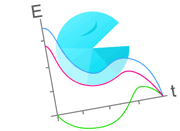The Information is Beautiful website has many illustrations of how the use of animated graphics lend a depth of understanding to complex data that is not apparent from tables or graphs. The valuable dataset generated by the PACE trial is large and complex, and would probably benefit from such treatment. The work is far beyond the capabilities of any one group, and would need to be considered by a variety of interested parties. It is unlikely that any study will reproduce a similar quantity of data in the near future: it must be a priority to make the PACE data freely available for others to study.
The therapies tested under the PACE trial are based upon two overlapping psychological models for CFS: fear avoidance and deconditioning. The weak average results show that this model is inadequate. The PACE study had no reason to assume that patients with fear avoidance and deconditioning would improve under Specialist Medical Care only: it is GET and CBT that were designed to treat these problems. This is very clear in the expectations stated in their protocol submission. If there is no clear difference between the profile of patients who showed most improvement in the SMC group and those who showed most improvement in the SMC+GET group, then the assumption is clearly wrong.
Since the original psychological model is inappropriate, it is useful to test alternative models. On the next page we offer a model of our own, and match it with a mathematical model of the pattern of responses that we would expect that model to produce under the PACE trial conditions. Obviously such data is fictional, but our model does predict that there will be no difference between the profile of the sub-group of patients that benefit most from the SMC only, and the sub-group that benefit most from GET+SMC.
summary more details
|





